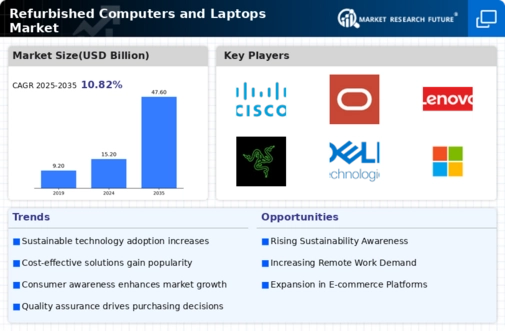Market Growth Projections
The Global Refurbished Computers and Laptops Market Industry is poised for substantial growth, with projections indicating a market size of 15.2 USD Billion in 2024 and an anticipated increase to 47.6 USD Billion by 2035. This growth trajectory suggests a robust demand for refurbished devices, driven by various factors including environmental awareness, cost-effectiveness, and technological advancements. The compound annual growth rate of 10.94% from 2025 to 2035 further underscores the market's potential. These figures reflect a significant shift in consumer preferences towards refurbished products, highlighting the industry's evolving landscape.
Growing Environmental Awareness
The increasing global emphasis on sustainability and environmental conservation drives the Global Refurbished Computers and Laptops Market Industry. Consumers and businesses alike are becoming more conscious of electronic waste and its environmental impact. Refurbished devices offer a viable solution by extending the lifecycle of electronics, thereby reducing waste. This trend is reflected in the projected market growth, with the industry expected to reach 15.2 USD Billion in 2024. As awareness continues to rise, the demand for refurbished products is likely to increase, encouraging manufacturers to invest in refurbishment processes and promote eco-friendly practices.
Corporate Sustainability Initiatives
Many organizations are implementing sustainability initiatives that prioritize the use of refurbished computers and laptops, significantly impacting the Global Refurbished Computers and Laptops Market Industry. Corporations are increasingly recognizing the importance of reducing their carbon footprint and promoting responsible consumption. By opting for refurbished devices, businesses can not only save costs but also demonstrate their commitment to sustainability. This trend is likely to gain momentum as more companies adopt green policies, thereby contributing to the overall growth of the market. The alignment of corporate strategies with environmental goals indicates a promising future for refurbished technology.
Cost-Effectiveness of Refurbished Devices
The economic advantages associated with purchasing refurbished computers and laptops significantly contribute to the growth of the Global Refurbished Computers and Laptops Market Industry. Consumers are increasingly seeking budget-friendly alternatives to new devices, especially in regions with limited purchasing power. Refurbished products typically offer substantial savings, often ranging from 30 to 50% compared to their new counterparts. This cost-effectiveness appeals to both individual consumers and organizations looking to optimize their IT budgets. As a result, the market is projected to expand, with estimates suggesting a growth to 47.6 USD Billion by 2035.
Technological Advancements in Refurbishment
Advancements in technology related to refurbishment processes enhance the quality and reliability of refurbished computers and laptops, thereby positively influencing the Global Refurbished Computers and Laptops Market Industry. Innovations in testing, repair, and quality assurance ensure that refurbished devices meet high performance standards. This technological evolution not only boosts consumer confidence but also encourages businesses to adopt refurbished solutions as viable alternatives. As refurbishment techniques improve, the market is likely to see a compound annual growth rate of 10.94% from 2025 to 2035, reflecting a growing acceptance of refurbished products in various sectors.
Increased Adoption in Educational Institutions
Educational institutions are increasingly adopting refurbished computers and laptops as a cost-effective solution to meet their technological needs, thereby propelling the Global Refurbished Computers and Laptops Market Industry. Schools and universities often face budget constraints, making refurbished devices an attractive option for equipping students with necessary technology. This trend is particularly evident in developing regions where funding for new devices is limited. The growing reliance on technology in education, coupled with the affordability of refurbished products, suggests a sustained demand for such devices in the coming years, further driving market growth.






















Leave a Comment